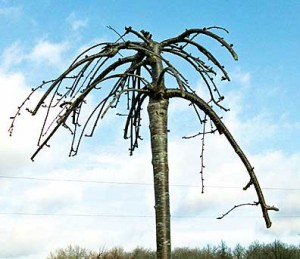

What we mean is that each weeping cherry tree has two parts. The roots and trunk (called “rootstock” by nurserymen) are actually a fast-growing sweet wild cherry like the ones that grow along the roadside, but trained to a single straight trunk. The weeping part or “top-graft” is either double-flowering pink Higan cherry or “Snow Fountains” white weeping cherry. The two plants are grafted together at the top of the trunk, three to five feet from the ground. The weeping section provides an umbrella effect if it is pruned regularly, or can grow 25 or 30 feet tall if not cut back.

It is common for sprouts or “suckers” to grow on the trunk or rootstock. If these are allowed to grow they will shoot straight up and take over the tree, ruining the weeping effect. There is a graft scar at the top of the trunk, just below the weeping branches. Anything that sprouts below the graft scar is wild cherry, not weeping cherry, and must be removed. This can be done at any time of year, the sooner the better.
People often ask how to “trim” weeping cherries. Anywhere you trim, weeping cherries will fork. To get the best effect you should trim within a foot or two of the top graft. This looks really awful at first but will quickly create more shoots and lead to a thicker appearance. The best time to trim weeping cherry trees is just after they bloom in early spring.
We get lots of requests for “dwarf” weeping cherry trees. There is actually no such thing. Any weeping cherry tree will eventually grow to thirty feet tall and twenty feet wide if not constantly pruned back. The small weeping cherry trees you see in landscapes are probably still young; when they outgrow the space most people remove them and start over. Clipping the tree each season can limit its size, but it wants to get big.
Young weeping cherry trees are typically top-heavy and need staking for the first year or two to keep them straight. We’ve seen many people try to prop them up by heaping dirt around the base or planting them deeper, but this will kill the tree fairly quickly. Planting any tree deeper than it was growing in the pot or root ball smothers it and kills it.
Over-watering is another frequent mistake with weeping cherry trees. Cherry rootstocks are actually very rugged and will tolerate dryness, but they are very sensitive to excessive wetness and will drown if over-watered. A deep-root soaking (five gallons or so) once a week is usually enough to maintain newly planted weeping cherry trees. Once the trees are established they should not need watering at all.
Japanese beetles and tent caterpillars love cherry trees, weeping cherries included. Spraying in May and June with BT or fruit tree spray can prevent this problem. Another fix is applying Milky Spore under cherry trees, which will control Japanese beetle grubs quite well over a long period.
Steve Boehme is the owner of GoodSeed Farm Nursery & Landscape, located on Old State Route 32 three miles west of Peebles. More information is available online at www.goodseedfarm.com or call (937) 587-7021.
